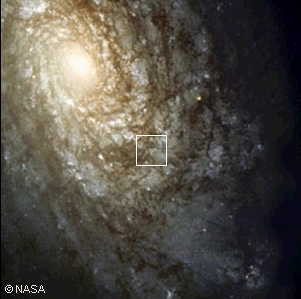More at 1 zettameterIn the early 1920's there was still considerable debate about the fuzzy blobs appearing in telescopes -- were they relatively small groups of stars, dust, and gas within the Milky Way or were they huge collections of stars similar to the Milky Way but at great distances? Was the Milky Way the entire universe or just a small, isolated piece of a much larger universe? In 1924, Edwin Hubble measured the distance to the Andromeda nebula, a faint patch of light with about the same apparent diameter as the moon. He established that it was at least 100 000 times further away than nearby stars, showing that Andromeda was a separate galaxy far outside the Milky Way. With this discovery, Hubble vastly increased the size of the universe. By 1929 Hubble was able to determine that most galaxies were receding from the Milky Way, and that the speed of their recession was proportional to their distance -- the universe itself was expanding. Edwin Hubble had changed forever our place in the universe. Galaxies are classified by their appearance. The classes of galaxies include elliptical, spiral, barred spiral, and irregular. There are many collections of photos of galaxies on the Internet. For a good description of the types of galaxies and photographic examples, visit Galaxies (one of many excellent SEDS sites -- Students for the Exploration and Development of Space). Another SEDS link includes a collection of non-Messier objects with many photos of various types of galaxies. |
